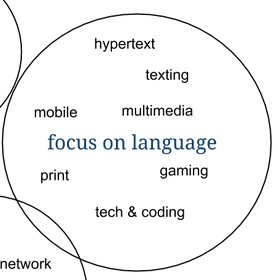Language

Figure 1. 2 This image has been adapted from a similar image in the Digital Literacies book. Citation- Dudeney, G., N. Hockly, & M. Pegrum. (2013). Digital Literacies. Harlow: Pearson.
In the image, texting, coding, and mobile are some of the key words associated with language. The goal of getting technology into the hands of billions of people worldwide is a reality. Technology has gotten smaller and has become more accessible and available to people worldwide. In the past, computers were large, heavy, and clunky. We accessed them at schools, libraries, and at work. Billions of people now carry cellphones and many of our learners have smartphones. Our technology is part of our routines and rituals. We carry them on us daily and use them frequently to entertain ourselves, communicate with our friends and family, perform work tasks, and more. Our language has adapted to the design of the technology and to help us communicate faster. Typing on a cellphone is very different than writing with a pen or having a conversation in person. Social networks like Twitter limit members to 140 characters for their messages. We want to be able to type more quickly, yet say what we need to with a limited amount of words. All these factors result in big changes to our language.
Additionally, chatting with digital devices means we lose the ability to read body language and listen to vocal cues and intonation. Meaning derives on us knowing the emotions behind the language. Expressions like LOL! and OMG! are often used in text speech to give us clues. Emoticons are also used in chat forums and status updates to give us these clues. These adaptions to our language have been adopted by millions which have resulted in us seeing these changes in our spoken language (Crystal, 2009).
Students need to be aware that language and communication change when we communicate through digital tools. First, there is a greater opportunity for misunderstanding because we don’t get the nonverbal. This means our learners have to evaluate what they read online and take the time to decipher the meaning. Our learners also have to learn how to craft their messages in ways they won’t be misunderstood.
Additionally, we need to be aware that we communicate differently in each social forum. In order to communicate properly we have to know the idiosyncrasies of that language. Hashtags, rts, dms and @ signs are key components of Twitter’s language. Not until recently did Facebook adopt hashtags into their language. Memes, quotes, liking and tagging are part of Facebook’s language. Reblogging and remixing are main components of Tumblr’s language.
Students should also be aware of the various languages that have emerged in the digital world, such as various coding languages. Creating with digital tools means our students should be somewhat familiar with these languages in order to utilize the app and tool to produce what they envision. In this course, participants will learn how to embed their completed tasks.
